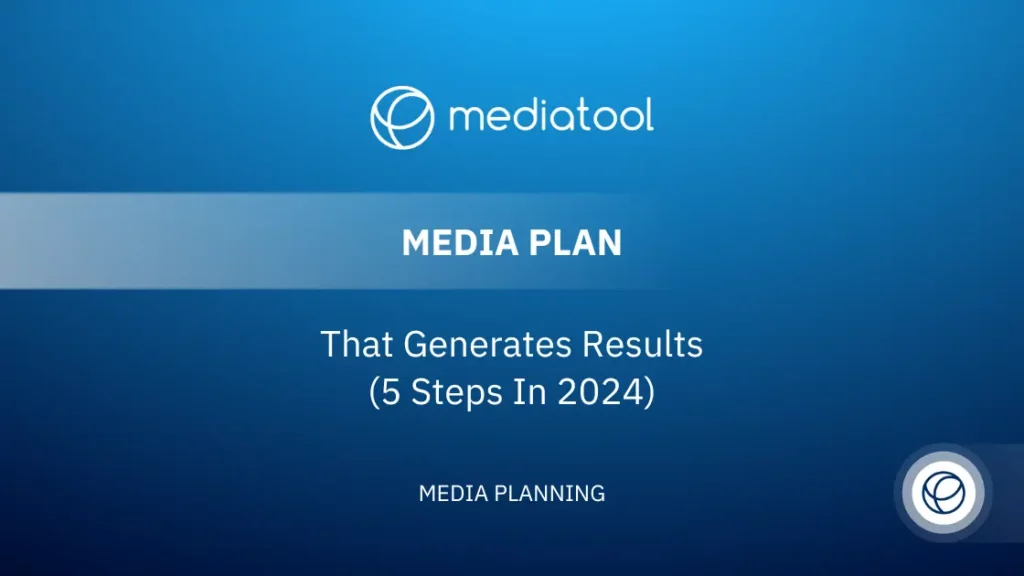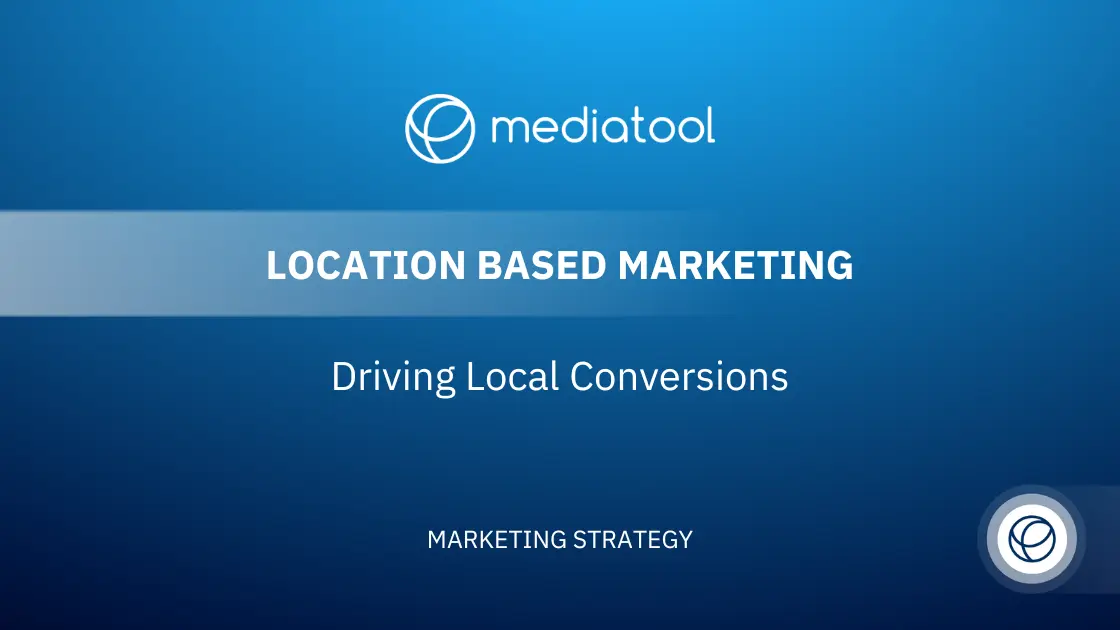Plus, practical media plan examples to kick-start your planning process
This article takes a how-to approach.
We’re getting hands-on with the planning process, showing you exactly how to develop a working media plan that will:
- Maximize your return on media investment (ROMI)
- Enable you to achieve your marketing goals
- Adapt in an ever-changing advertising landscape
Plus, some real-world media plan examples to help you contextualize the whole thing.
What is a Media Plan?
A media plan is a strategic document prepared by media planners and media buyers to outline how a company will use various media channels to achieve its marketing and advertising objectives.
This plan specifies which media platforms will be used, the timing of the media campaign, and how the allocated budget will be spent to reach the intended audience effectively.
It integrates a variety of elements such as market research, audience insights, media channel selection, budget allocation, and campaign execution strategies to ensure that the advertising efforts are well-coordinated and targeted.
The Role of Research and Collaboration
Developing an effective media plan requires thorough market research to understand the competitive landscape and identify the most efficient ways to reach potential customers.
Media planners and buyers work closely together, leveraging their insights and expertise to select the best media channels, negotiate ad placements, and optimize the overall media strategy.
An essential part of this process is to conduct market research, which is critical for uncovering insights about audience behaviors, preferences, and the effectiveness of various media channels.
This collaborative effort ensures that the media plan is based on solid data and strategic analysis, leading to more effective and targeted advertising campaigns.
Why Do You Need a Media Plan?
Creating a media plan is essential for several compelling reasons, all of which contribute to the effectiveness and success of your marketing and advertising efforts. Here’s a closer look at the importance of having a media plan:
Ensures Targeted Communication
A media plan is critical because it ensures that your advertising efforts are directed at your specific target audience.
Understanding your audience’s demographics, interests, and media consumption habits allows for precise targeting.
This targeted approach increases the likelihood that your message will be seen by those most likely to be interested in your products or services, making your advertising more effective and efficient.
Aligns with Business Objectives
A well-crafted media plan aligns your marketing activities with your overall business goals.
Whether you aim to increase brand awareness, boost sales, or enhance customer engagement, a media plan helps you set clear objectives and outlines the steps to achieve them.
This alignment ensures that every marketing effort contributes to the broader goals of your organization, providing a clear direction for your campaigns.
Optimizes Budget Allocation
Budget efficiency is another crucial reason to develop a media plan.
It guides the allocation of your advertising budget across various channels and platforms, ensuring that you invest in the most effective media to reach your target audience.
This strategic allocation helps maximize the return on your investment, avoiding wastage on channels that do not perform well for your specific audience or objectives.
Facilitates Measurement and Adjustment
A media plan is not static; it provides a framework for ongoing measurement and optimization of your campaigns. By setting benchmarks and monitoring performance, you can identify what works and what doesn’t.
This continuous evaluation allows for real-time adjustments to your strategy, ensuring that your marketing efforts remain effective and responsive to changes in the market or consumer behavior.
Provides Competitive Advantage
Having a structured media plan can give you a competitive edge. It enables you to strategically place your advertising in a way that differentiates your brand from competitors.
By carefully selecting channels and crafting messages that resonate with your target audience, you can stand out in a crowded marketplace, capturing the attention of potential customers more effectively.
Builds Long-term Brand Value
Finally, a media plan contributes to building and maintaining the long-term value of your brand. Consistent and strategic advertising efforts, guided by a comprehensive media plan, reinforce your brand message and values across all touchpoints.
This consistency helps in building a strong brand identity, fostering customer loyalty, and ultimately, contributing to the long-term success of your business.
Types of Media Planning

Understanding the Spectrum of Media Planning Strategies
Media planning is not a one-size-fits-all process. It encompasses a range of strategies tailored to meet specific marketing objectives and target audience preferences.
From traditional media channels like television and print to digital landscapes including social media platforms and paid media, each type offers unique advantages.
A comprehensive media planning strategy involves selecting the right mix of these channels to optimize reach and engagement.
Traditional Media Planning: Focuses on media buying in conventional channels such as TV, radio, and print. Ideal for reaching broad demographics, this strategy leverages audience insights to place ads where they’ll have maximum impact.
Digital Media Planning: Revolves around targeting potential customers through digital channels. This includes everything from social media posts on platforms like Facebook and Twitter to paid ads on Google. Digital advertising allows for precise targeting and real-time campaign performance analysis.
Social Media Planning: Utilizes social media accounts to increase brand awareness and customer engagement. It’s about creating a media plan that aligns with the marketing strategy while leveraging the viral nature of social media.
Integrated Media Planning: Aims to provide a seamless experience across all media platforms, blending traditional and digital channels. This strategy ensures consistent messaging and maximizes marketing efforts by reaching the target audience wherever they are.
Leveraging Media Planning Tools and Templates
A successful media planner employs a variety of media planning tools and templates to streamline the planning process. These resources help in conducting market research, creating buyer personas, and devising a media plan document that aligns with the business goals.
Advanced tools like Google Analytics play a crucial role in tracking the success of digital media planning efforts, enabling marketers to adjust their strategies in real-time.
Challenges of Media Planning

Navigating the Complex Media Landscape
The media landscape is ever-evolving, with new media platforms emerging and consumer behaviors shifting. Media planners must stay abreast of the latest media trends to identify relevant media channels that resonate with their intended audience.
This requires continuous market research and the ability to adapt media planning strategies accordingly.
Budget Constraints: Allocating the marketing budget effectively across different media channels remains a significant challenge. Media planners need to balance between paid, owned, and earned media to ensure optimal use of resources.
Achieving Targeted Reach: Identifying and reaching the target market with precision involves understanding audience insights deeply. The media planning process must be flexible enough to adapt to changes in target audience behavior.
Measuring Campaign Performance: With a variety of advertising campaigns across multiple channels, gauging the success of each can be daunting. Media planners rely on metrics like conversion rates, engagement rates, and ROI to assess campaign performance, yet integrating data from disparate sources remains a challenge.
Keeping Up with Technological Advancements: The rapid pace of technological change affects media buying, audience targeting, and campaign tracking. Media planners must continuously learn and adopt new technologies to enhance their media strategy.
Overcoming the Challenges
While 84% of global marketers now integrate streaming platforms into their media strategies, fewer than half find their investment in streaming to be effective, underscoring the ongoing challenge of measuring its value.
A thorough media planning strategy involves anticipating these challenges and developing proactive measures to address them. This includes leveraging media planning templates for efficient planning, conducting comprehensive market research to understand the target audience, and employing media planning tools for real-time analytics and insights.
Ultimately, the goal is to create a media plan that not only reaches the intended audience but also achieves the marketing objectives, thereby maximizing the return on media investment.
Without further ado, here are the five steps to a working media plan:
1. Know Your Target Audience
There’s no point in buying media if your target audience doesn’t see it. Before building a media plan, you should be familiar with your customers. 82% of marketers emphasize that access to high-quality data about their target audience is critical for their success.
And not just on the surface. With so much first-party data available now, it’s easier than ever to create rich customer profiles and create micro-segments to deliver more relevant brand experiences.
Before you spend a single dollar on advertising, you should have a clear idea of your target audiences:
- Age
- Gender
- Income level
- Interests
- Media consumption habits
Some ad planners create ‘avatars,’ composite (sometimes idealistic) profiles with their target customer’s traits. They then use that avatar to determine where their target audience consumes media – online, in print, television, or radio – to inform the media planning process.
Whether this works for you depends on your audience segments. Global brands will find the task tricky, as their audiences are diverse in every sense of the word.
This is where first-party data is essential for an effective marketing plan. For example, a media plan based on intuition will likely reflect the brand goals.
54% of marketing leaders in the U.S. report that their greatest challenge is understanding customer data to pinpoint current trends and needs for effectively reaching their audiences.
That makes sense on paper and gives marketers a feeling of control over the message. But a media plan that uses digital marketing data to hone the channel and content mix will always be more effective at cutting through the noise.
We’ll explain how to do that shortly.
2. Define Goals For Your Media Plan
You can only measure the success or failure of your efforts if you set clear goals. And you can only set clear goals with a solid strategy.
Media planning targets need to be grounded in business goals.
For example, a plan might target a 3% conversion rate from media exposure to actual sales. Or the marketer might want 7% of people who see their message to visit the site and sign up for a newsletter.
Those figures mean almost nothing without context.
A good tip here is to link media planning goals to customer value. CEOs and CMOs want to know that marketing activity contributes to business growth, so make customer value your ‘north star’ from the start.
Mediatool’s Strategic Planning feature simplifies this process, enabling marketers to closely monitor their contribution to business goals. In the Strategic Planning timeline, you get a birds-eye view of targets and budgets, bringing results in line with high-level targets.
3. Use Smart Tools for Your Media Plan
The days of flying blind or solo while putting together a media plan are over.
Martech (marketing technology) makes it easier for media planners to collaborate with colleagues and clients while developing strategies and launching campaigns faster.
Investing in MarTech that suits your organization’s requirements is key.
Mediatool is one example of media planning software ideal for global brands and growing agencies. With Mediatool, marketing teams can plan, organize, manage and optimize media investments in one browser-based platform.
With the ability to control user access and keep media planning files and communications in one place, Mediatool is ideal for brands and agencies that want the balance of security and flexibility in an end-to-end platform.
4. Determine the Perfect Media Mix
The media landscape is diverse and dynamic. Veteran media planners will still remember when TikTok ads weren’t a ‘thing,’ and media buying was manual.
As digital marketing becomes more multi-channel and customers seek personalized experiences, media planners face two intertwined challenges:
- Delivering the best customer experience
- Optimizing limited budgets
Marketing data is the essential ingredient for optimized media plans. Collecting, analyzing, and interrogating your data allows you to understand where your audience wants to consume media.
Of course, there’s no such thing as the “perfect” media mix from the outset. Adopting an agile marketing approach means your team can develop and launch campaigns faster, monitor performance, and adjust advertising investments.
An interesting shift in the landscape is noted by Gartner, predicting that by 2024, 70% of brands will reallocate at least 10% of their media budget to product placement within entertainment content. This trend underscores the importance of staying ahead in identifying and leveraging emerging media opportunities to ensure your marketing efforts resonate well with your target audience.
Mediatool makes that process possible in real-time. With a wide range of third-party integrations and real-time data feeds, you can track, analyze, and optimize media investments to boost ROMI.
5. Execute Your Media Plan
You might have noticed that we jumped from the media mix to launching a campaign. Don’t worry; we’ll double back shortly with some examples of media plans.
Launching a campaign doesn’t mean the media planning process is complete. It simply means you’re ready to put ideas into action, typically by:
- Buying ad space in publications
- Going live with social media ads
- Building a search advertising campaign
- Sending creative to media vendors
- Launching programmatic ads
Of course, the specific mix of tactics and platforms you use is based on the insights gleaned from data.
The key takeaway from this step is that a media planner’s job is still ongoing when the media plan launches. As soon as content goes live, you should monitor results, gather insights from marketing data, and recommend optimizations.
Mediatool enables this agility while allowing you to keep media plans, conversations, and budgets. Agencies can keep client data separate in secure folders, and brands can collaborate across time zones to break down siloes.
Plus, as results flow into Mediatool, you can filter and segment data to identify top-performing assets and channels. This insight is invaluable for testing new ideas and optimizing your media plan.
Media Plan Examples
There are four key ingredients to a media plan:
The Calendar
A media planner’s calendar is their bible. But if you search “media plan example” online, you’ll see many results that look like spreadsheets.
Ignore them.
Media planning is more dynamic and collaborative than spreadsheets allow. Martech enables media planners to create and edit calendars in seconds as things change.
Mediatool’s media planning calendar provides this simplified view, giving media planners an easy-to-read flowchart. But all the information marketers and media planners need is in the calendar. They can expand, filter, adjust the view, and explore creative assets all within the calendar screen.
Approval Flow
Modern marketing teams need tools that enable real-time collaboration, authentic conversation, and transparent planning. Media planners are too busy to deal with missing file versions or inflexible systems.
Mediatool’s enriched approval flow is built for better collaboration and transparent feedback. Media planners can share files, track comments, implement edits and submit approval requests without leaving the platform.
Strategic Oversight
It’s easy to lose sight of the bigger picture when you get deep into the media planning process. But media planners must keep an eye on strategic goals as they develop channel plans.
Formalizing this link from the start makes reporting and optimizing much easier later. In other words, media planners should have a way to plan, measure, evaluate and improve that links marketing activity to business goals.
That’s where Mediatool’s Strategic Planning tool is so valuable. In the Strategic planning view, targets link to high-level goals, creating a birds-eye view of all marketing activity.
Content and Creative
The final ingredient is a place to keep media content. Many versions and iterations of content are created throughout the media planning process. Media planners need to attach the final approved content to ad placement information so they can track everything going out into the world.
This task becomes significantly more complex as you create multivariate tests with new content ideas.
But Mediatool makes it easy.
Content is stored in the calendar view, so media planners can quickly check which creative is associated with what placement. You never need to worry about losing track of content because the approved version – plus the approvals process and all associated communication – is available in a couple of clicks.
Wrapping Up
This guide has walked you through the essential steps of creating a media plan that really works in 2024. We’ve covered everything from knowing who your audience is, setting clear goals, picking the right tools, mixing your media smartly, to finally getting your plan into action.
It’s clear that having a strong media plan isn’t just a good idea—it’s a must-have for any successful marketing strategy. By following these steps, you’re not just spending your budget wisely, you’re also making sure your message hits home with the people who matter most to your business.
Remember, in the fast-paced world of advertising, staying ahead means staying planned. So, take what you’ve learned here and use it to boost your marketing game. Here’s to making your media plan a big win for your brand!
Ready to Take Your Media Planning Potential to the Next Level?
Book a demo of Mediatool to see how the end-to-end tool simplifies the media planning process for better results at every stage.
Better planning. Better collaboration. Better management, tracking, and optimization.
It all adds up to better marketing campaign management with Mediatool.





